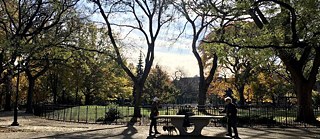New York
Tompkins Square Park

Tompkins Square Park, a 10-acre, mixed-use public square in New York City’s East Village, is equal parts cultural intersection and urban backyard. Unlike parks of similar size — Washington Square Park, Bryant Park, Fort Greene Park—Tompkins Square is not noticeably iconic. It isn’t recognized by an arch or fountain; it is not a sprawling field. But for its residents and daily visitors, passers-by tourists and lunch-break workers, Tompkins Square Park is a recreational haven and a geography of historical importance.
Today, squaring off from East 7th Street to East 10th Street, between Avenues A and B, Tompkins Square Park has something for everyone. A large, multi-use street court in the northwest corner invites skateboarders, footballers and hockey players. Refurbished gated playgrounds welcome families and children along the east and west avenue entrances. Basketball and handball courts are available in the park’s northeast corner, next to a small above-ground pool open seasonally. In the opposite corner, at East 7th and Avenue A, 16 granite chess tables fill out the lower southwest of the park.
There is no grand entrance. Instead, Tompkins Square Park can be accessed from every direction and is halved by a large walking path that connects East 9th Street. In the center of the Square, a circular walking loop lined with park benches surrounds a central lawn shaded by sycamore trees, black locusts, and American elms. Before the lawn, just south of it, a large open space is available for concerts and gatherings. And just beyond it, towards Avenue B and 9th Street is a large, triangular dog run—the first of its kind in New York City—arguably the park’s biggest attraction.
And just beyond it, towards Avenue B and 9th Street is a large, triangular dog run—the first of it’s kind in New York City—arguably the park’s biggest attraction.
On a sunny day in late November, I spoke with Officer Carl Winslow, a Pit Bull Cattle
Dog, and his owner, David, who visit the Dog Run daily. “It’s really the only reason to come,”
David said, “especially with the improvements made over the last year or so.” Legend has it that the park’s bathrooms, which are located on either side of a quiet courtyard and
picnic area, were once a seedy, drug-fueled hangout. As recently as 2012, Complex ranked them the second-worst public bathrooms in New York City. But after 311 calls, the city sent in a task force for a thorough clean-up.
The Tompkins Square Park Dog Run, which opened in 1990, is funded and maintained by
community volunteers—not the city. In 2008, it underwent $450,000 in renovations that added benches and tables, underground drainage, watering pools and separate areas for large and small dogs. Many believe that these improvements have fostered a unanimous spirit for keeping the park safe and clean.
The organizing committee, Friends of First Run, maintain the Dog Run through
donations; most famously, through the help of the annual Tompkins Square Park Halloween Dog Parade, the largest dog costume parade in the world. This year, held the weekend before Halloween, the event drew over 500 costumed dogs to the park. Grace Chiu, an education consultant from the Upper West Side, and her Yorkshire Terrier, Pip Puddleglum (dressed as Amelia Dogheart), was a first-time entry at the event.
“Surprisingly, this parade truly brings people together,” said Chiu. I thought I was the
only ‘crazy dog lover’ in this city. But I’m clearly not the only one. We New Yorkers love our dogs!”
The organizing committee, Friends of First Run, maintain the Dog Run through donations; most famously, through the help of the annual Tompkins Square Park Halloween Dog Parade, the largest dog costume parade in the world.
Pip, who’d been specially trained to perch on a miniature single-engine plane throughout
the parade, walked away with an honorable mention—and, thanks to a shout-out in The New York Times—increased his Instagram followers to more than 6,000. (For the curious, he lives at @yorkieinnewyorkie.)
As any area deemed for public use must grapple with that use looks like, Tompkins
Square Park has not always been a stage for fun and games. Originally a swamp, Tompkins
Square was gifted to the city by Peter Stuyvesant in 1837 and opened to the public in 1850. Within only a few years it had become an unofficial stage for protest. According to the New York City Parks Department, Tompkins Square has hosted periodic protests against joblessness and
economic inequality for 160 years, after a work-shortage rally started there in 1857.
In the 1980s the park became a point for protests against the rapid shift in gentrification.
After the city changed park curfew hours and erected a cast-iron fence, protesters saw this as an action to displace the city’s homeless who often stayed there overnight. After tensions increased in 1988, the park closed and underwent a series of renovations. It reopened to the public in 1990.
Gigi Sam, a Turkish immigrant who has lived in the neighborhood for 30 years, misses
the days when the neighborhood felt more local when the buildings weren’t all owned by
anonymous management companies. “This area, from here to the river, it all used to be empty,” he said, between drags on a cigarette. “Now, it’s all new, and it’s new money. It feels less like the neighborhood it used to be.” Though he also admits that the park has cleaned up for the better.
On the opposite side of the park, two women played ping-pong on one of the park’s
concrete tables, as their Cavalier King Charles Spaniel looked on. The women, who withheld their names, were Polish immigrants who have lived in the neighborhood for 14 and 7 years respectively. Unlike Mr. Sam, they weren’t disappointed at all with the path of gentrification in and around the park. “It’s a wonderful place,” one said. “I come here for exercise. But it’s a place of love.”